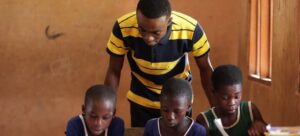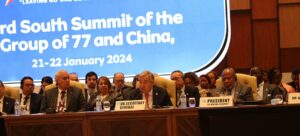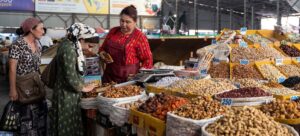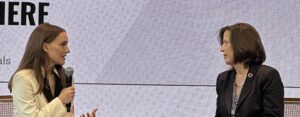The flagship forecast launched in New York on Thursday indicates that last year’s stronger-than-expected GDP growth coming out of the COVID-19 pandemic masked short-term risks and structural vulnerabilities in the world economy.
The sombre short-term outlook is based on persistently high interest rates, further escalation of conflicts, sluggish international trade, and increasing climate disasters, which all pose significant challenges to global growth.
It points to a prolonged period of tighter credit conditions and higher borrowing costs, presenting strong headwinds for a world economy saddled with debt and in need of more investments to resuscitate growth, fight climate change and accelerate progress towards the Sustainable Development Goals (SDGs).
Escape the quagmire: Guterres
“2024 must be the year when we break out of this quagmire. By unlocking big, bold investments we can drive sustainable development and climate action and put the global economy on a stronger growth path for all,” said UN chief António Guterres.
“We must build on the progress made in the past year towards an SDG Stimulus of at least $500 billion per year in affordable long-term financing for investments in sustainable development and climate action.”
So how do the numbers breakdown? We’ll begin our analysis with the scourge of rising prices that continues to bedevil economies large and small:
Inflation
Global inflation is projected to decline further, from an estimated 5.7 per cent in 2023 to 3.9 per cent in 2024. But price pressures are still elevated in many countries and any further escalation of geopolitical conflict will add to that.
In about a quarter of all developing countries, annual inflation is projected to exceed 10 per cent in 2024, the report highlights.
Since January 2021, consumer prices in developing economies have increased by a cumulative 21.1 per cent, significantly eroding the economic gains made following the COVID-19 recovery.
“Persistently high inflation has further set back progress in poverty eradication, with especially severe impacts in the least developed countries,” said Li Junhua, Head of the UN’s Department of Economic and Social Affairs (DESA).
“It is absolutely imperative that we strengthen global cooperation and the multilateral trading system, reform development finance, address debt challenges and scale up climate financing to help vulnerable countries accelerate towards a path of sustainable and inclusive growth.”
Regional disparities
The United States, the world’s largest economy, is expected to see a drop in GDP growth from 2.5 per cent in 2023 to 1.4 per cent in 2024. Consumer spending, a key driver of its economy, is likely to weaken due to various factors, including high interest rates and a softening labour market the report says.
Meanwhile China, facing domestic and international headwinds, is projected to experience a moderate slowdown with growth estimated at 4.7 per cent in 2024, down from 5.3 last year.
Europe and Japan also face challenges with growth rates forecasted at 1.2 per cent for both regions in 2024.
Africa’s growth rate is projected to slightly increase from 3.3 per cent in 2023 to 3.5 in 2024.
The report notes that the least developed countries (LDCs) are projected to grow by 5 per cent in 2024, yet this falls short of the 7 per cent growth target under the SDGs
Labour markets
The global labour market presents a mixed post-pandemic picture. Developed countries experienced a robust recovery with low unemployment rates, notably 3.7 per cent in the US and 6 per cent in the EU in 2023, coupled with rising nominal wages and narrowing wage inequality.
However, real income losses and labour shortages pose challenges.
Developing countries show mixed progress; while nations like China, Brazil, Türkiye, and Russia report declining unemployment, gender gaps, and high youth unemployment persist.
Globally, the decline in women’s labor force participation to 47.2 per cent in 2023 (compared to 48.1 in 2013) and the high NEET rate (not in employment, education or training) of 23.5 per cent among youth highlight enduring challenges.
Global Investment
There is a noted slowdown in investment growth across both developed and developing economies.
While developed countries have continued to channel investments into sustainable and technology-driven sectors like green energy and digital infrastructure, developing countries face challenges such as capital flight and reduced foreign direct investment.
Global investment growth is expected to remain low due to economic uncertainties, high debt burdens, and rising interest rates.
Investment in the energy sector, especially in clean energy, is growing but not at a pace sufficient to meet the net-zero-emissions goal by 2050.
International trade
International trade is losing steam as a growth driver, with global trade growth weakening to 0.6 per cent in 2023, recovering to 2.4 per cent in 2024.
The report points to a shift in consumer spending from goods to services, rising geopolitical tensions, supply chain disruptions, and the lingering effects of the pandemic as factors impeding trade growth.
Furthermore, the shift towards protectionist policies in some countries has also influenced trade dynamics, leading to a reevaluation of global supply chains and trade agreements.
International finance and debt
Developing countries face high levels of external debt and rising interest rates, making access to international capital markets difficult. There’s a decline in official development assistance and foreign direct investment for low-income countries.
Debt sustainability has emerged as a critical challenge, especially for developing countries, in the wake of rising debt levels and changing global financial conditions.
The increase in global interest rates, a consequence of monetary policy tightening by central banks like the Federal Reserve and the European Central Bank, has escalated debt servicing costs, particularly for countries with foreign currency-denominated debts.
As a result, many countries are grappling with the need for debt restructuring.
Climate change
2023 saw extreme weather condition worsen, including the hottest summer on record since 1880 leading to devastating wildfires, floods and droughts worldwide.
These events have direct economic impacts, such as damage to infrastructure, agriculture and livelihoods.
Studies have predicted substantial losses to the global economy due to climate change. For instance, some estimates suggest a potential reduction of about 10 per cent in global GDP by 2100, considering events like the collapse of the Greenland ice shelf.
Other models indicate that without mitigation of global warming, average global incomes could be 23 per cent lower by 2100.
Multilateralism: Blueprint for action
The 2024 WESP report calls for urgent action to address these diverse challenges.
It emphasizes the need for strengthened global cooperation, particularly in areas like climate action, sustainable development financing, and addressing the debt sustainability challenges of low and middle-income countries. Enhanced global cooperation is essential.
































